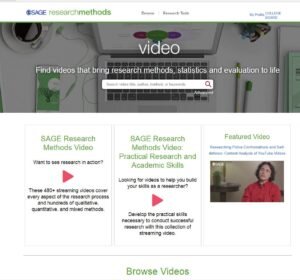SRM Videos to Match Research Readiness
This series of posts corresponds to the 2018 SAGE Research Methods Open House. If you would like to access the SAGE e-books, articles, case studies, videos, and datasets mentioned in these posts, explore SAGE Research Methods with a free trial.
Sometimes we just want a clear explanation. We want someone to connect the proverbial dots, share real-world experiences, and help us understand complex ideas or practices. SAGE Research Methods houses a growing collection of videos that bring research, academic, and professional skills to life. How can you find the ones that answer your questions, or the questions of your students?"Build a cognitive bridge between where a student is coming from, and where they need to go." This characteristic of meaningful learning, drilled into me in grad school, seems useful here. Students with course projects, theses, or dissertations to complete come to us with some level of prior knowledge of research. How can we quickly assess where they are coming from so we can recommend resources will help build a cognitive bridge to where they need to go?Bloom's Taxonomy was developed in the 1950s and refined in 2000 as a framework for planning and assessing learning. The Taxonomy for the cognitive domain laid out a progressively more complex levels of thinking. Inter-relationships between these levels allow us to see ways that students can bridge from acquiring basic understanding of a subject to being able to evaluate it, then to create new solutions or interpretations. We can use this taxonomy to think about students' research readiness, and more precisely match available resources.
 Student and novice researchers need the foundations associated with the Remember and Understand before they can Apply these principles in an assignment or Evaluate the methodologies and methods from which to choose for their own research. At the highest level, they use what they have learned to create the research design, and create new contributions to the literature and practice.Bridge Knowledge Gaps with VideosLet's look at a way to use this approach for matching video resources to students' research readiness.
Student and novice researchers need the foundations associated with the Remember and Understand before they can Apply these principles in an assignment or Evaluate the methodologies and methods from which to choose for their own research. At the highest level, they use what they have learned to create the research design, and create new contributions to the literature and practice.Bridge Knowledge Gaps with VideosLet's look at a way to use this approach for matching video resources to students' research readiness. A student with questions about basic concepts at the Remember level, might benefit from viewing:
A student with questions about basic concepts at the Remember level, might benefit from viewing:
- What Are the Practical Steps for Doing a Research Project?
- Core Skills for New Researchers: How Curiosity Drives the Research Process
- Usefulness of Research
Next, they might find organizational and writing tips to be helpful:
- Academic Writing: How to Get Started and Keep Going
- How Do I Keep a Bibliography?
- So what does a learning journal do?
If they want to apply research ideas in their designs, they might like:
- How to Formulate Effective Research Questions
- Core Skills for New Researchers: How to Develop a Good Research Question
- Top Tip: Encouraging Engagement with Your Research
If they are at the point where they need to analyze data, suggest:
- Some Features of Data
- Let’s Tear Evidence into Shreds
- The Importance of Challenging Assumptions
A student who needs to evaluate literature or research options might learn from:
- Core Skills for New Researchers: How to Solve Problems & Make Decisions
- Mike Wallace & Alison Wray Discuss Critical Reading
- What is Critical Thinking?
Students who are ready to create ways to present what they have learned could take advantage of:
- How to Find Your Voice as a Writer
- Sharing and Publishing Research: Skills for Success
- Writing & Publishing for Your Audience
Bloom's Taxonomy allows us to pose the kinds of questions that will help us quickly assess which resources will allow students to take the important steps and bridge from where they are now to a place where they are knowledgeable and creative. While many types of resources will be essential to the research journey, videos provide a personal and engaging way to learn from others' insights and experiences. You can access and view the selected videos by clicking the links. Access the entire collection of videos with the SRM Open House log in.
You can access and view the selected videos by clicking the links. Access the entire collection of videos with the SRM Open House log in.
Anderson, L., Bloom, B. S., Krathwohl, D., & Airasian, P. (2000). Taxonomy for learning, teaching and assessing: A revision of Bloom's Taxonomy of Educational Objectives (2nd ed.). New York: Allyn & Bacon, Inc.Bloom, B., Engelhart, M., Furst, E., Hill, W., & Krathwohl, D. (1956). Taxonomy of educational objectives: Book 1, Cognitive domain. New York: David McKay and Company.
